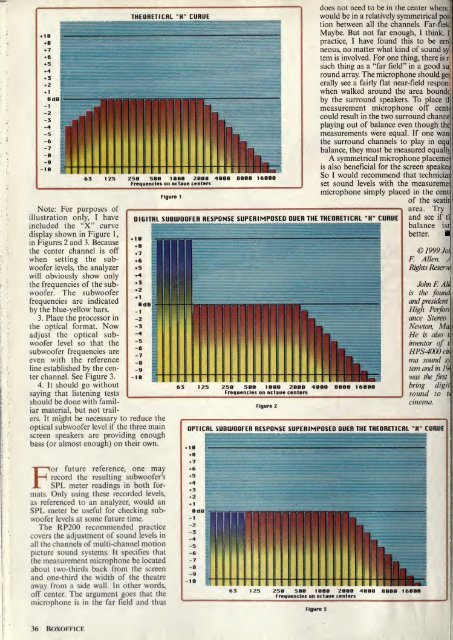You also want an ePaper? Increase the reach of your titles
YUMPU automatically turns print PDFs into web optimized ePapers that Google loves.
j<br />
THEORETICRL "H" CURUE<br />
Note: For purposes of<br />
illustration only, I have<br />
included the "X" curve<br />
display shown in Figure 1<br />
in Figures 2 and 3. Because<br />
the center channel is off<br />
when setting the subwoofer<br />
levels, the analyzer<br />
will obviously show only<br />
the frequencies of the subwoofer.<br />
The subwoofer<br />
frequencies are indicated<br />
by the blue-yellow bars.<br />
3. Place the processor in<br />
the optical format. Now<br />
adjust the optical subwoofer<br />
level so that the<br />
subwoofer frequencies are<br />
even with the reference<br />
line established by the center<br />
channel. See Figure 3.<br />
4. It should go without<br />
saying that listening tests<br />
should be done with familiar<br />
material, but not trailers.<br />
It might be necessary to reduce the<br />
optical subwoofer level if the three main<br />
screen speakers are providing enough<br />
bass (or almost enough) on their own.<br />
Maybe. But not far enough, I think. ]<br />
practice, I have found this to be err(<br />
neous, no matter what kind of sound sy<br />
tern is involved. For one thing, there is ri<br />
such thing as a "far field" in a good su^<br />
round array. The microphone should geij<br />
erally see a fairly flat near-field respon:?<br />
when walked around the area bound^j<br />
by the surround speakers. To place tl<br />
measurement microphone off cent<br />
could result in the two surround channe<br />
playing out of balance even though the<br />
measurements were equal. If one wan<br />
the surround channels to play in equ<br />
balance, they must be measured equall}<br />
A symmetrical microphone placemei<br />
is also beneficial for the screen speakei<br />
258 588 1888 2888 4888 8888 16888<br />
So I would recommend that techniciai<br />
Frequencies on octaue centers<br />
set sound levels with the measuremei<br />
microphone simply placed in the cent'<br />
Figure 1<br />
of the seatir<br />
area. Try<br />
DIGITRL SUBWOOFER RESPONSE SUPERIMPOSED OUER THE THEORETICRL "K" CURUE and see if tl<br />
balance isr<br />
I i I i li 1; t! tlEr^::<br />
63 125 258<br />
I<br />
588 1888<br />
I !<br />
2888 4888 8888 16088<br />
Frequencies on octaue centers<br />
Figure 2<br />
better.<br />
©1999 Jo)<br />
F. Allen, a<br />
Rights Reserve<br />
John F. All<br />
\<br />
is the found<br />
and president<br />
High Perforr\<br />
once Stereo I<br />
Newton, Mai<br />
He is also r.<br />
inventor of f.<br />
HPS-4000 cirl<br />
ma sound 5>j<br />
tern and in 19<<br />
was the first<br />
bring dii^ii<br />
sound to tn<br />
cinema.<br />
OPTICRL SUBUJOOFER RESPONSE SUPERIMPOSED OUER THE THEORETICRL "K" CURUE<br />
For<br />
future reference, one may<br />
record the resulting subwoofer's<br />
SPL meter readings in both formats.<br />
Only using these recorded levels,<br />
as referenced to an analyzer, would an<br />
SPL meter be useful for checking subwoofer<br />
levels at some future time.<br />
The RP200 recommended practice<br />
covers the adjustment of sound levels in<br />
all the channels of multi-channel motion<br />
picture sound systems. It specifies that<br />
the measurement microphone be located<br />
about two-thirds back from the screen<br />
and one-third the width of the theatre<br />
away from a side wall. In other words,<br />
off center. The argument goes that the<br />
microphone is in the far field and thus<br />
258 58B 1888 2888 4888 8888 16888<br />
Frequencies an octane centers<br />
Figure 9<br />
36 BOXOFFICE

















